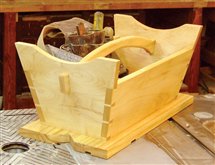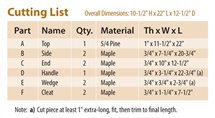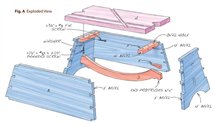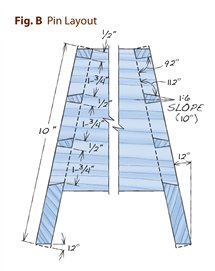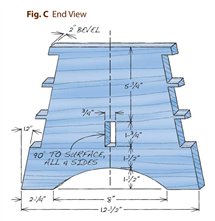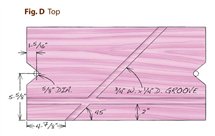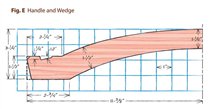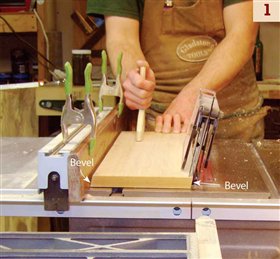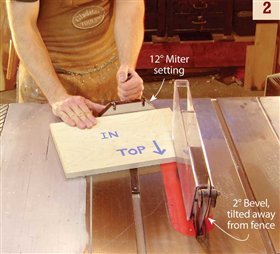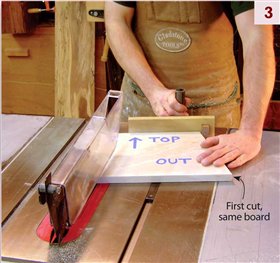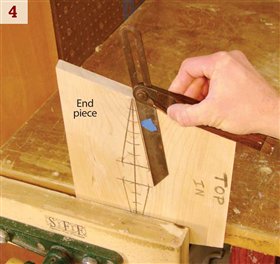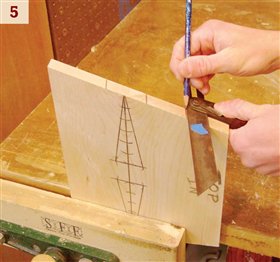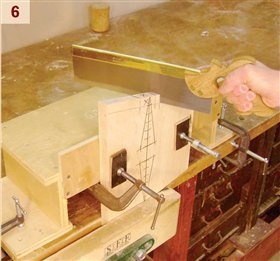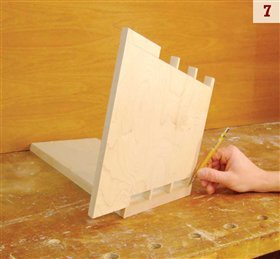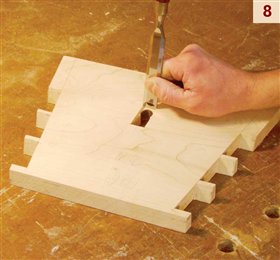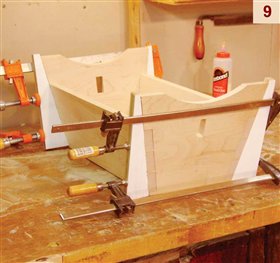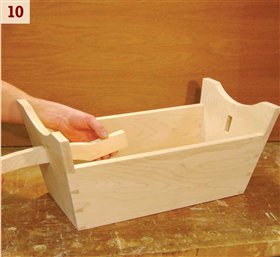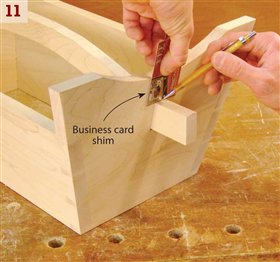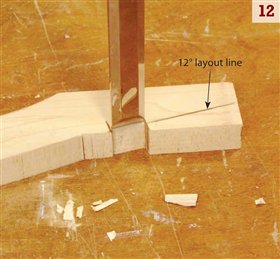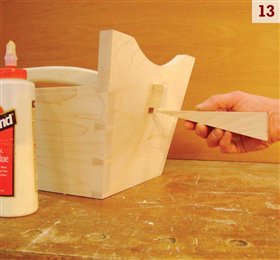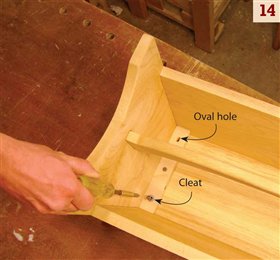For my job as a trim carpenter and furnituremaker,
I’ve always needed a sturdy stool to stand
on. I’ve also wanted to make a nice box for carrying
my tools and a small workbench for cutting molding.

While perched on an overturned bucket
one day, I thought, “Why not combine all three?”
The StepBox was born.
The StepBox has splayed sides for stability,
ample room for my tools, and grooves and notches in the top for
holding pieces of molding and drilling holes.
Building the StepBox gave me an opportunity
to learn how to make a challenging joint: the compound-
angle dovetail. While I could have merely
screwed the parts together, I wanted a stronger
joint. Dovetails are definitely the way to go. When
I stand on the stool, the joints actually tighten.
This project is built to last!
Materials
I made the base and handle of my
StepBox from 3/4″ hard maple. As
you know, this wood is very strong.
It can easily take my weight and
more when I stand on the stool.
Maple is also a good choice for
dovetailing. Pencil lines are easy to
see, and it cuts and pares cleanly,
without splintering. But because it’s
so hard, I have to keep my saw and
chisels extra-sharp.
I made the top from a 1″ thick
stair tread. It’s Southern yellow
pine—a tough wood, like maple,
but not as heavy. The top must withstand
a lot of wear and tear (I may
even drill into it occasionally), so I
used a piece of wood that would be
easy and inexpensive to replace.
The challenge
The StepBox’s base splays 12° in
both directions. It won’t tip over,
even when I stand with my feet right
on the edge. The splay also makes it
easier to fi sh out tools from the box
and drop them back inside.
Creating this splay is quite interesting:
You must cut the ends of all
four base pieces at a compound
angle. You might think that merely
mitering the pieces at 12° would do
the trick. It doesn’t. In order for all
four pieces to butt together, you
must bevel their ends at 2° as well.
These compound angles can
make your head spin. But you
won’t go wrong if you follow my
technique. Even so, I strongly suggest
that you make a complete base
from scrap wood first, to familiarize
yourself with each step, before cutting
into your expensive maple.
Cut the compound angles
Joint and plane the sides (B) and
ends (C) to final thickness. Crosscut
them about 1″ extra-long and
rip them about 1/4″ extra-wide.
Tilt the blade of your tablesaw to
12° and rip one long edge of each
piece. Flip each piece over and rip it
to final width (Photo 1). I clamped
a board to my fence so the bevel
didn’t get trapped under the fence.
Mark your pieces well. Stand
each board on edge, long side down, so you can clearly see which
way it leans. Think of the board as
one face of a pyramid with its top
cut off, as shown in Fig. A (below).
Using a carpenter’s pencil, write
Top—In and Top—Out in big, bold
letters on both sides of each piece.
Get ready to make the first cut
on the end of each board. The procedure
to follow depends on which
way your sawblade tilts:
• For a left-tilt saw: Place your
miter gauge in the right-hand slot.
Rotate its head counterclockwise to
make a 12° cut (Photo 2). (Depending
on how your gauge is marked,
the reading will be 12° or 78°.) Tilt
the blade to 2°. Place each board
so the In side faces up and the Top
edge faces away from you. Cut the
end. Repeat this process for each
board. To cut the opposite ends,
move the miter gauge to the other
side of the blade (Photo 3). Fasten
a fence to the miter gauge, so you
can screw or clamp a stop block to
it. (You’ll need the stop block to
ensure that matching pieces are
cut the same length.) Flip over
each board so the Out side faces up
and the Top edge butts against the
miter gauge. Make the cuts.
• For a right-tilt saw: Place your
miter gauge in the right-hand slot.
Rotate its head clockwise to make
a 12° cut (the opposite direction
from the one shown in Photo 2).
Tilt the blade 2°. Place each board
so the Out side faces up and the Top
edge butts against the miter gauge.
Make the cut. For the second cut,
move the miter gauge to the lefthand
slot. Flip each board so the In
side faces up, and Top edge faces
away from you.
Cut the dovetails
If you thought the angles are tricky
so far, just wait! Laying out these
dovetails can make your eyes go
crossed—the angles just don’t look
right when you first draw them.
Fortunately, I used a foolproof system
for drawing the dovetails. Let me quickly
show you how it works, and then
we’ll move on.
Lay out the pins first (Fig. B). Draw a pair of large triangles on the
inside face of each end board. The
long sides of the triangle represent
the pitch of the dovetails (in this
case, the familiar 1:6 ratio). Place
a sliding bevel on the face of the
board and set it to match the right
side of the triangle (Photo 4). Place
the square on the end of the board
and draw the right side of each pin
(Photo 5). Reset the sliding bevel to
the left side of the triangle to draw
the left side of each pin. That’s the
gist of it.
If you’ve made through dovetails
before, the rest is pretty standard. I
won’t claim it’s easy—just familiar.
You saw and chop the pins (Photo 6),
then lay out, saw and chop the tails
(Photo 7). Accurate layout is the
key to the whole process.
Mortises and arches
Before assembling the base, drill
and chop mortises for the handle
(D, Fig. C). Although the base has
a 12° splay, the top and bottom
walls of the mortises don’t lean at
12°—they’re square to the faces of
the end pieces. Use a pencil to lay
out the mortises on both sides of
each piece. Outline the perimeter
of the mortise with a knife or chisel.
Using a wide chisel, pare to
these scribed lines to establish a
shallow shoulder all the way around
the mortise. Do this on both the
front and back sides of the workpiece.
Use a 5/8″ Forstner bit in a
drill press to remove most of the
waste, then finish the mortise by
hand (Photo 8).
There’s one more task before
assembly: Cut arches on the bottom
side of both ends. The arches form
four feet. They give the stool more
stability on an uneven surface than
if the ends were left straight. Draw
the arches on the Out face of each
end piece. Tilt your bandsaw table
12° and cut the arches. Sand them
smooth. These surfaces should look
good, since they’ll face up when
you tote the StepBox around.
Glue the base
Make four gluing blocks, tapered
at 12° (Photo 9). It may be tempting
to use the offcuts from the base pieces, but their grain runs the
short way. They could easily crack
and break, and that would be really
bad news during a glue-up.
Make the blocks from a soft
wood, such as pine, with the grain
going the long way. Why use a soft
wood? If the pins stick out a bit,
they’ll crush into the wood, allowing
the block to continue pushing
against the tails—where you want
the pressure.
Glue a thick piece of paper onto
the face of each block. The paper
will absorb the glue squeeze-out
and prevent the blocks from adhering
to the base.
Glue and clamp the base. Plane,
scrape or sand the dovetails so
they’re flush.
Make the handle
Saw out the handle (D, Fig. E), leaving
it 1″ or so extra-long on both
ends. (Note that the drawing shows
it cut to final length.) Don’t saw out
the notches on each end of the handle
yet—you’ll mark their locations
directly from the base.
Slide the handle into the base
(Photo 10). Draw a line across the
top side of each end, using a business
card as a shim (Photo 11). This
shim deserves some explanation.
Let’s say you just drew the line for
each notch flush up against the
base. After cutting the notches,
you’d find that the distance
between them would be too short.
You have to allow the extra distance
caused by the splay of the base, and
that’s where the shim comes in.
Withdraw the handle and saw
and chop the notches (Photo 12).
Stick the handle back in the base
and test the fit of the joints. Adjust
as necessary. When all is well,
remove the handle and round over
the section between the notches
with a spokeshave. Test how it feels in your hands, and make it rounder
or slimmer to suit.
Prepare two 12° wedges (E) for
locking in the handle. Make them
extra-long, so they’ll be easier to
make and install.
Brush glue on the handle’s
notches and slide the handle in
place. Apply glue to the wedges and
lightly tap them in place (Photo 13).
After the glue is dry, cut the handle
and wedges so they protrude 3/4″
beyond the end pieces. Soften their
edges with a file and sandpaper.
Add the top
Cut the top (A) to final size. Cut
both grooves in the top using a
dado set in your tablesaw (Fig. D).
Use a miter gauge and fence for
making the 45° groove. To make
the notches, first drill a hole for
each one, then cut the notches on
the bandsaw.
Make the cleats (F) that will be
used to fasten the top. Note that
the outer holes in the cleats are
oval (Fig. A). This allows the top to
shrink and swell without cracking.
Glue the cleats to the base.
Apply finish to the base and
top, then fasten the top to the base
(Photo 14).
Cutting List

Fig. A: Exploded View

Fig. B: Pin Layout

Fig. C: End View

Fig. D: Top

Fig. E: Handle and Wedge

|
|
Click any image to view a larger version.

1. Rip 12° bevels on
the long edges of
the side and end
pieces. Note that
both edges are
beveled, and that
the bevels lean
the same way.

2. Saw an angled
end on each
piece. This is
a compound
cut: The miter
gauge is set at
12°; the blade is
tilted to 2°. (See
“Compound-
Angle Butt Joints”,
below.) The
inside surface of
the board must be
facing up.

3. Make the
second cut on
the other side of
the blade. Leave
the miter gauge
and blade at the
same settings,
but flip over the
workpiece, so the
outside surface is
facing up.

4. Lay out the
dovetails. Start
with the pins.
First, draw a
large triangle on
the board that
indicates the pitch
of the dovetails.
Set your sliding
bevel directly
from the triangle.

5. Transfer this
angle to the end
of the board. The
right side of the
triangle shows the
correct angle for
the right sides of
the pins.

6. Saw the pins.
This is a bit
trickier than
sawing standard
dovetails. Every
cut is a compound
angle—it leans
two ways. I use an
auxiliary support
to raise the
workpiece and
to keep it from
chattering.

7. Draw around
the pins to mark
the tails. Sawing
and chopping
out the tails is
no different than
making standard
tails, but once
again, these will
all be compound
angles.

8. Drill and chop
mortises for the
handle. There are
no compound
angles here—all
sides of the
mortise are square
to the surface.

9. Glue the base.
Use triangular
blocks to prevent
the clamps
from slipping or
digging into the
wood.

10. Insert a partially-sawn
handle into
one mortise, then
pass it on through
the second
mortise. The ends
of the handle are
cut extra-long for
now.

11. Draw a line
across each end
of the handle. This
line marks the
outside shoulder
of a notch you’ll
cut in the handle.
Use a shim behind
the pencil to
compensate for
the splay of the
end pieces. Pull
out the handle.

12. Saw and pare
the notches.
Slide the handle
back through the
mortises and see
if the notches fit
the ends. If all is
well, remove the
handle and round
its faces with a
spokeshave.

13. Glue the handle
to the base. Slide
in a large 12°
wedge to lock the
handle in place.
After the glue is
dry, saw the end
of the handle and
the wedge to final
length.

14. Attach the top.
It’s fastened
through cleats
that are glued
to the base. The
outside holes in
the cleats are oval,
to allow the top
to move without
cracking. |




